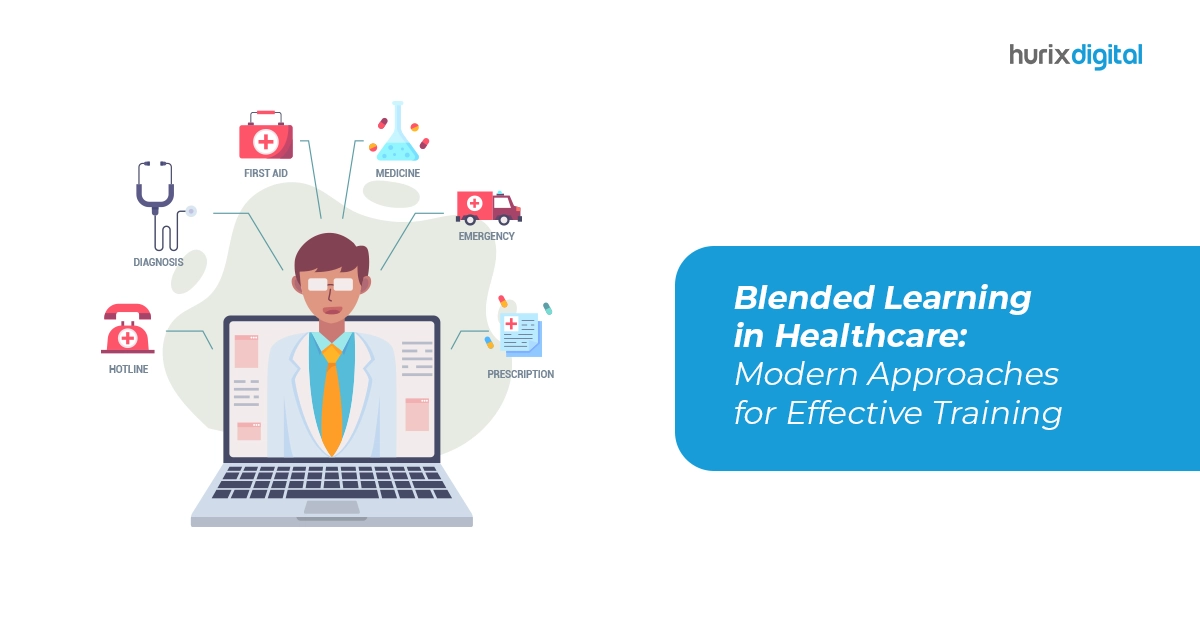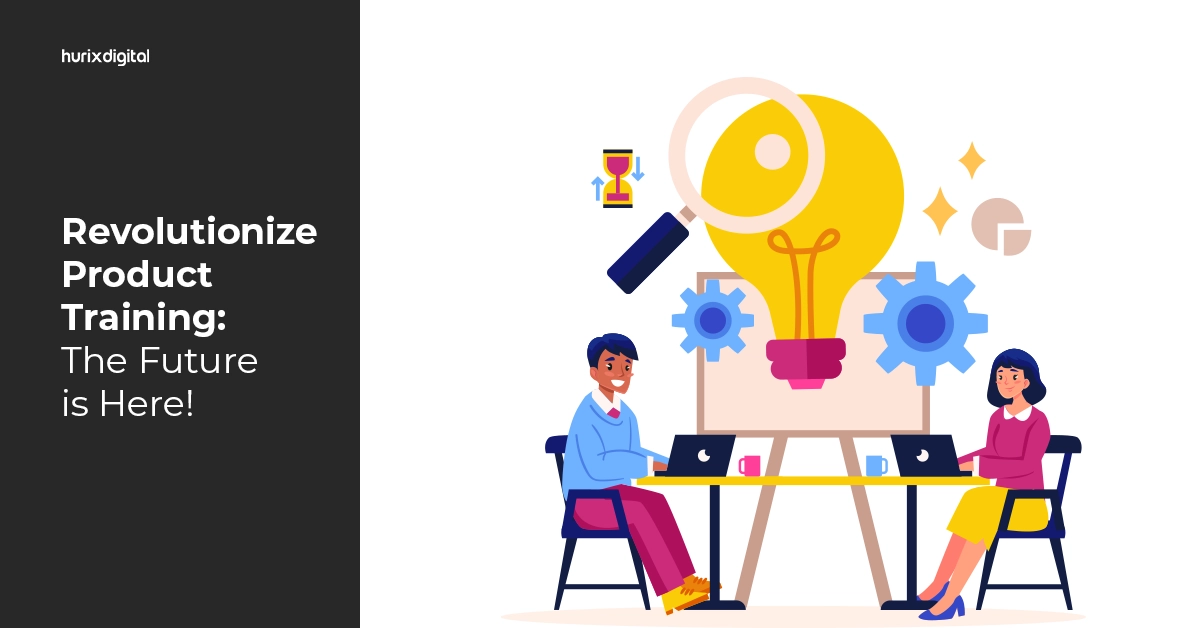
Guide to Use Blended Learning for Corporate Training
[vc_row][vc_column][vc_column_text]As technology evolves and impacts all aspects of our daily lives, education and learning cannot be left unaffected. However, evolving refers to moving to the next level without decimating the old, or in other words, it means taking the best of both the worlds – the positives of the old and adding on to it, the advantages of the new. In the case of education, this manifests as blended learning – the benefits of classroom teaching complimented with the rich use of emerging technology to make learning more real-time, contextual, engaging, immersive and interesting.
Blended learning combines traditional face-to-face learning with peers, or teammates in an organizational context, with online learning to meet the evolving needs of students, employees, educators, trainers, and academicians. Basically, blended learning helps to take learning outside the walls of the classroom, making it possible to access resources both online and offline, anytime and anywhere.[/vc_column_text][vc_custom_heading text=”How to Use Blended Learning in Corporate Training:” font_container=”tag:h2|font_size:18|text_align:left” google_fonts=”font_family:Lato%3A100%2C100italic%2C300%2C300italic%2Cregular%2Citalic%2C700%2C700italic%2C900%2C900italic|font_style:900%20bold%20regular%3A900%3Anormal” css=”.vc_custom_1681897346252{margin-top: 0px !important;margin-bottom: 0px !important;border-top-width: 0px !important;border-bottom-width: 0px !important;padding-top: 0px !important;padding-bottom: 10px !important;}”][vc_column_text]Most organizations, for decades, have followed the tried and tested instructor-led employee training format to train employees, mainly because it is highly effective. However, it has its share of issues such as logistics, scheduling trainer-led sessions, and the high cost of corporate training.
Given the ever-changing technology landscape, it becomes imperative for organizations to ensure continuous training for employees to remain relevant in the market. However, continuous learning through the traditional classroom format would be expensive and logistically unfeasible; therefore, there was need for a new form of learning and the digital environment came to the rescue and gave birth to what is now known as blended learning, a hybrid approach to learning, utilizing both classroom and web-based learning methodologies. This trend is now growing at a feverish pace, and reports suggest that the global e-learning market is expected to grow at a CAGR of 11.091% during 2014-2019.[/vc_column_text][vc_custom_heading text=”Benefits of Blended Learning for Employee Training:” font_container=”tag:h2|font_size:18|text_align:left” google_fonts=”font_family:Lato%3A100%2C100italic%2C300%2C300italic%2Cregular%2Citalic%2C700%2C700italic%2C900%2C900italic|font_style:900%20bold%20regular%3A900%3Anormal” css=”.vc_custom_1556114693018{margin-top: 0px !important;margin-bottom: 0px !important;border-top-width: 0px !important;border-bottom-width: 0px !important;padding-top: 0px !important;padding-bottom: 10px !important;}”][vc_custom_heading text=”1. Makes Classroom Learning More Efficient:” font_container=”tag:h2|font_size:18|text_align:left” google_fonts=”font_family:Lato%3A100%2C100italic%2C300%2C300italic%2Cregular%2Citalic%2C700%2C700italic%2C900%2C900italic|font_style:900%20bold%20regular%3A900%3Anormal” css=”.vc_custom_1556115040523{margin-top: 0px !important;margin-bottom: 0px !important;border-top-width: 0px !important;border-bottom-width: 0px !important;padding-top: 0px !important;padding-bottom: 10px !important;}”][vc_column_text]In a blended learning environment, the instructor can introduce and set the context of a lesson in the classroom and then ask learners to complete certain sections of the lesson on their own using web-based resources. This is not only time-saving but also gives the instructors more time to clarify doubts and assess the comprehension levels of the learners in the classroom. Consider the following scenario, employees are provided some web links in advance to read up information related to their classroom training. By the time they come to the classroom, they are already familiar with what is going to be taught. Since they already have a context, they are better positioned to grasp the lesson. Besides, it also provides employees more time to discuss with the instructors and also clarify their doubts. Thus, blended learning is not only time saving, but it also moves away from the traditional way of teaching which involved transfer of knowledge from the teacher to the taught. In blended learning, the conversation is more equal with learners also taking responsibility for their own learning.[/vc_column_text][vc_custom_heading text=”2. Enables Learners to Plug Existing Knowledge Gaps:” font_container=”tag:h2|font_size:18|text_align:left” google_fonts=”font_family:Lato%3A100%2C100italic%2C300%2C300italic%2Cregular%2Citalic%2C700%2C700italic%2C900%2C900italic|font_style:900%20bold%20regular%3A900%3Anormal” css=”.vc_custom_1556115048917{margin-top: 0px !important;margin-bottom: 0px !important;border-top-width: 0px !important;border-bottom-width: 0px !important;padding-top: 0px !important;padding-bottom: 10px !important;}”][vc_column_text]Another advantage of blended learning is that it can be used to ensure that all learners have the same level of knowledge. In a traditional classroom setting, not all learners have the same level of understanding and retaining. However, using online resources, learners can build on their classroom experience, fill their knowledge gaps and be at the same level as the rest of the team. By giving advance intimation of training sessions, learners can come prepared by plugging their knowledge gaps and thus benefit from the training. In another context, some pharmaceutical companies are using blended learning courses where medical reps with no relevant life sciences background are asked to take and pass online courses before attending classroom sessions. This ensures that all learners, irrespective of their educational backgrounds, benefit from instructor-led training in classroom settings.[/vc_column_text][vc_custom_heading text=”3. Saves Time and Money:” font_container=”tag:h2|font_size:18|text_align:left” google_fonts=”font_family:Lato%3A100%2C100italic%2C300%2C300italic%2Cregular%2Citalic%2C700%2C700italic%2C900%2C900italic|font_style:900%20bold%20regular%3A900%3Anormal” css=”.vc_custom_1556115060300{margin-top: 0px !important;margin-bottom: 0px !important;border-top-width: 0px !important;border-bottom-width: 0px !important;padding-top: 0px !important;padding-bottom: 10px !important;}”][vc_column_text]According to estimates by IBM, almost 40% of classroom employee training costs are spent on travel and lodging. Online employee training helps to cut down not only travel and lodging costs but also all logistics costs related to classroom employee training. Further, it also helps to reduce the number of man-hours lost in traveling, resulting in increased productivity. With learning materials available both online and offline, organizations can ensure that employees have access to all relevant information at the time when they most need them.[/vc_column_text][vc_custom_heading text=”4. Flexible Training Complimented with a Human Touch:” font_container=”tag:h2|font_size:18|text_align:left” google_fonts=”font_family:Lato%3A100%2C100italic%2C300%2C300italic%2Cregular%2Citalic%2C700%2C700italic%2C900%2C900italic|font_style:900%20bold%20regular%3A900%3Anormal” css=”.vc_custom_1556115069777{margin-top: 0px !important;margin-bottom: 0px !important;border-top-width: 0px !important;border-bottom-width: 0px !important;padding-top: 0px !important;padding-bottom: 10px !important;}”][vc_column_text]Blended learning allows learners to learn at their own pace, in the comfort of their own space. At the same time, it adds the much needed warmth of a human interaction, enabling learners to interact with a subject expert not only to discuss and clarify their doubts but also seek motivation in case of self-doubt and any insecurity that could otherwise affect their progress.[/vc_column_text][vc_custom_heading text=”How to Implement Blended Learning for Corporate Training:” font_container=”tag:h2|font_size:18|text_align:left” google_fonts=”font_family:Lato%3A100%2C100italic%2C300%2C300italic%2Cregular%2Citalic%2C700%2C700italic%2C900%2C900italic|font_style:900%20bold%20regular%3A900%3Anormal” css=”.vc_custom_1556114718468{margin-top: 0px !important;margin-bottom: 0px !important;border-top-width: 0px !important;border-bottom-width: 0px !important;padding-top: 0px !important;padding-bottom: 10px !important;}”][vc_custom_heading text=”1. Take Your Employees into Confidence:” font_container=”tag:h2|font_size:18|text_align:left” google_fonts=”font_family:Lato%3A100%2C100italic%2C300%2C300italic%2Cregular%2Citalic%2C700%2C700italic%2C900%2C900italic|font_style:900%20bold%20regular%3A900%3Anormal” css=”.vc_custom_1556115080172{margin-top: 0px !important;margin-bottom: 0px !important;border-top-width: 0px !important;border-bottom-width: 0px !important;padding-top: 0px !important;padding-bottom: 10px !important;}”][vc_column_text]For decades, organizations have been following the traditional classroom setting for training. To successfully transition to blended learning, organizations must give the employees time to adapt to a new learning environment. While the only constant is change, change is always met by resistance as it is requires people to leave their comfort zones. Besides, not all employees are equally tech-savvy. Advance intimation gives them time to brush up their basic online skills and also be mentally prepared for the changes ahead. A well-reasoned explanation goes a long way in building employee confidence and gaining their acceptance for the new approach.[/vc_column_text][vc_custom_heading text=”2. Develop Your Blended Learning Program Based on Learning Outcomes:” font_container=”tag:h2|font_size:18|text_align:left” google_fonts=”font_family:Lato%3A100%2C100italic%2C300%2C300italic%2Cregular%2Citalic%2C700%2C700italic%2C900%2C900italic|font_style:900%20bold%20regular%3A900%3Anormal” css=”.vc_custom_1556115088949{margin-top: 0px !important;margin-bottom: 0px !important;border-top-width: 0px !important;border-bottom-width: 0px !important;padding-top: 0px !important;padding-bottom: 10px !important;}”][vc_column_text]There are several blended learning formats you can follow:
- Online: An instructor delivers lessons via an online platform using eLearning resources complimented by periodic face-to-face meets.
- Rotation: Students rotate between self-paced learning and classroom learning.
- Flexible: Most learning takes places through the online platform but instructors provide additional support through small group settings.
- Online lab: The learners come together in a physical classroom, and an online teacher delivers the lessons with the help of an on-site professional.
- Personalized blended model: This model straddles the physical and virtual spaces based on learner needs.
- Self-blended model: Students take online classes to supplement their classroom learning.
- Face-to-face learning: Lessons are delivered using online media by an on-site instructor.
Choose the one that best meets your learning outcomes.[/vc_column_text][vc_custom_heading text=”3. Keep Your Employee Preferences in Mind While Implementing Blended Learning:” font_container=”tag:h2|font_size:18|text_align:left” google_fonts=”font_family:Lato%3A100%2C100italic%2C300%2C300italic%2Cregular%2Citalic%2C700%2C700italic%2C900%2C900italic|font_style:900%20bold%20regular%3A900%3Anormal” css=”.vc_custom_1556115099786{margin-top: 0px !important;margin-bottom: 0px !important;border-top-width: 0px !important;border-bottom-width: 0px !important;padding-top: 0px !important;padding-bottom: 10px !important;}”][vc_column_text]It is good to keep your existing employee skill sets and their preferences in mind while designing your blended learning program. One way to go about this is to conduct a survey to find out the requirements of the end learners and the formats they prefer. For example, it is generally seen that sales people prefer to be part of an online community on which they can share their experiences and ask for advice. If you choose a format they are not comfortable with, you may not achieve your learning outcomes.[/vc_column_text][vc_custom_heading text=”4. Ensure That You Have the Right LMS to Deliver Blended Learning:” font_container=”tag:h2|font_size:18|text_align:left” google_fonts=”font_family:Lato%3A100%2C100italic%2C300%2C300italic%2Cregular%2Citalic%2C700%2C700italic%2C900%2C900italic|font_style:900%20bold%20regular%3A900%3Anormal” css=”.vc_custom_1556115112578{margin-top: 0px !important;margin-bottom: 0px !important;border-top-width: 0px !important;border-bottom-width: 0px !important;padding-top: 0px !important;padding-bottom: 10px !important;}”][vc_column_text]Not all LMS tools are created equal. Ensure that your LMS has all the relevant tools and features to support blended learning, for example, to inform learners about the schedule of classroom sessions, deliver pre-classroom training, conduct assessments and provide feedback, and host your repository of training materials.[/vc_column_text][vc_column_text]Not sure how to implement blended learning in your corporate training? We at HurixDigital can help. Talk to our experts to understand how we can help you transition your training online through our custom-made LMS solution that can support your blended learning requirements.[/vc_column_text][/vc_column][/vc_row]











